Soy: 3 Ways to Introduce Soy to Babies (…and why soy milk is not one of them)
- Katie's 3 favorite ways to introduce soy foods to baby: tofu, edamame hummus and soy flour
- Why soy milk is not the best way to introduce the potentially allergenic food soy to babies
- How babies can safely eat soy…no it is not a problem because of hormones.
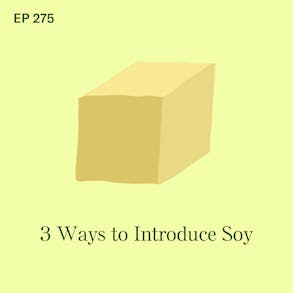
LISTEN TO THIS EPISODE
Episode Description
How can babies safely learn to eat soy? These are 3 of my favorite ways to offer your baby the potentially allergenic food soy…with 3 reasons why I don’t love soy milk for babies.
Links from This Episode
SOY powder and flour picks
- Bob’s Red Mill soy protein powder: use this in pancakes or mini muffins for babies, available on Amazon here (affiliate link)
- Injeolmi powder, kinako toasted soy flour…has a nutty flavor, usually use about ¼ amount of this in place of regular flour. Note regular flour has wheat - a separate allergenic food category from soy. You can use kinako to sprinkle on foods, rice cakes, blend into other purees or liquids or baking (can dry out foods though, so keep it to ¼ amount flour if substituting), available on Amazon here (affiliate link)
- Our dietitian Katelynn says her family uses kinako to dust on foods and also in sauces.
Edamame Hummus Recipe
Edamame are cooked soy beans. They are too small for early eaters to pick up. Edamame are safe for older infants who have their pincer grasp and practice eating multi-textured foods. You can make cooked soybeans into a homemade, low-sodium hummus that is a safe way to introduce your baby to the potentially allergenic food soy.
This recipe was adapted from a Food Network recipe and altered by a Registered Dietitian to make it more appropriate for baby-led weaning. Note that this recipe contains tahini which is sesame seed paste. Sesame is a separate allergenic food category from soy. Be sure your baby has had sesame a number of times on its own without reaction before trying this recipe for soy as the first time.
Ingredients
- 1 ½ cups frozen edamame (out of shell)
- ¼ cup tahini (sesame seed paste, unsalted)
- ¼ cup water
- 3 tablespoons lemon juice
- 1 garlic clove, smashed
- ½ teaspoon ground cumin
- 6 tablespoons olive oil
Instructions
- Boil the frozen edamame per instructions until cooked. Drain.
- In a food processor combine the cooked edamame, tahini, water, lemon juice, garlic, cumin and process until smooth.
- With the motor running slowly drizzle in the olive oil until absorbed. If the hummus drips off the end of a stainless steel spoon it is thin enough to serve to the baby. If still sticky, add more olive oil until achieving desired consistency.
- Baby-Led Weaning with Katie Ferraro program with the 100 First Foods™ Daily Meal Plan, join here: https://babyledweaning.co/program
- Baby-Led Weaning for Beginners free online workshop with 100 First Foods™ list to all attendees, register here: https://babyledweaning.co/baby-led-weaning-for-beginners
Other Episodes Related to this Topic

Latest Episodes
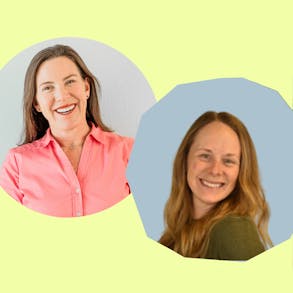
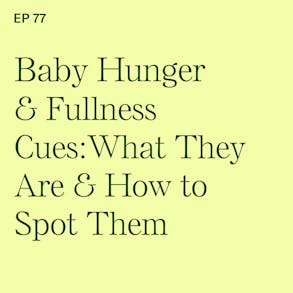
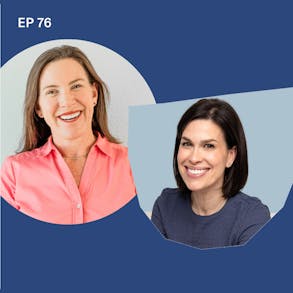
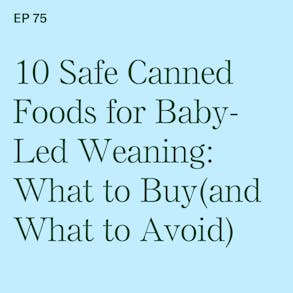
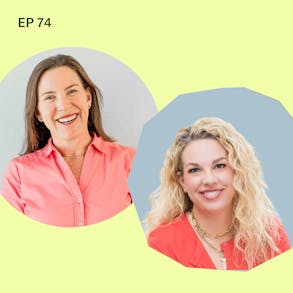
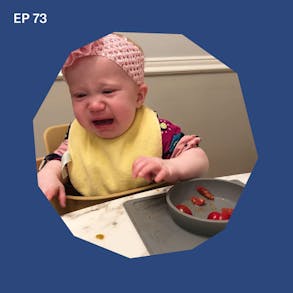
Katie Ferraro (0s):
So why do I not do soy milk as a way to introduce soy to babies? Well, for a couple of reasons. Number one, the added sugar factor in most soy milks means is not appropriate for early eaters. Number two, the fact that it's a thin liquid is harder for babies to swallow when they're early eaters, and then the amount of protein they actually drink is inconsequential. Hey there, I'm Katie Ferraro–registered dietitian, college nutrition professor, and mom of seven specializing in baby-led weaning. Here on the Baby-Led Weaning Made Easy podcast, I help you strip out all of the noise and nonsense about feeding, leaving you with the confidence and knowledge you need to give your baby a safe start to solid foods using baby-led weaning.
Katie Ferraro (41s):
Is it safe for babies to eat soy foods? And if so, what are the most easy, safest, ideal soy foods for babies to learn how to eat? Well, you might be aware that soy is one of the big nine allergenic foods. Those are the nine foods that account for about 90% of food allergy, so soy is on the list of foods we do wanna introduce to babies, and today I'm gonna share three ways that you can introduce soy to babies. All right, I'm gonna cut right to the chase here. Number one, if you've known me for any length of time, you could probably guess that my favorite way to introduce soy to babies is by using tofu. I absolutely love tofu for babies and baby-led weaning. It is a low sodium food. It is an affordable food.
Katie Ferraro (1m 21s):
It is a plant-based protein. It has a pretty impressive amount of iron, especially for a plant food, and it's a soy-based food. So you can cut tofu into strips about the size of your adult pinky finger. The baby can then use their whole hand or their palmar grasp to rake or scoop that food up and into their mouth. And when it comes to tofu, another kind of fun thing you can do is grab yourself a crinkle cutter, they are just a couple bucks on Amazon, and kind of give that ridged edge to the tofu strips, makes it a little bit easier for the baby to pick up. So number one favorite way is tofu. Number two favorite way is I like to do edamame hummus. Now, I don't do edamame, the small little cooked soybeans, for babies because early on in baby-led weaning at six and seven months of age, your early eater does not have their pincer grasp, so they can't pick up those very small pieces of food.
Katie Ferraro (2m 6s):
So offering a food like edamame is kind of ridiculous for an early eater because they can't pick it up and feed it to themselves. But you can take those cooked soybeans and you can make a hummus out of it. Now, hummus is a great dipper or topper that you can put on other starchy or even some protein foods. We always talk about adding sauces and dippers and toppers to make some of the more dry foods, more moist, cause more moisture makes it safer for the baby to swallow. You can make your own edamame hummus. I'll actually share a recipe for you on the Shownotes page for this episode, blwpodcast.com/275. I'm totally down with doing cooked soft edamame for older babies once they have that pincer grasp. But it's definitely not a first food that I start with.
Katie Ferraro (2m 46s):
A third way that you can do soy easily for your baby is by using soy flour or soy protein powder. I'll do just a tiny bit of this, usually mixed with regular wheat flour to make pancakes or mini muffins or even little fritters that I make for the baby. Now I, I mentioned that soy is one of the allergenic foods and we want to introduce it early and often, but if you're cutting it, so what happens with soy flour especially is that for baking, you usually only use it like general rule of thumb is one quarter of the amount of flour you could substitute with soy flour. If you do more than that, it's really high in protein; it tends to reduce the moisture content and dry the food out; and dry foods are choking hazards for babies. So I'll usually cut the soy powder or the soy flour with regular wheat flour and whatever I'm already making.
Katie Ferraro (3m 27s):
Wheat is a different and a separate allergenic food, so if you want more information on wheat and how to safely introduce wheat to your baby, go back and listen to the earlier podcast episode called "Wheat How to Introduce Your Baby to this Potentially Allergenic Food." That's episode number 29. Now, you might have noticed that soy milk is not on the list of soy foods I used to introduce to baby. That's because soy milk, we talked about plant based milks on the podcast in the past, and unless your baby is allergic to cow's milk protein or your family is vegan and doesn't eat animal foods, there's really no reason to avoid cow's milk. We don't substitute cow's milk in place of infant milk, breast milk, or formula until after baby is one.
Katie Ferraro (4m 8s):
But we want your baby trying the cow's milk protein. Sometimes parents are like, "Oh, I just wanna do soy milk." Many of the soy milk products out there have added sugar in them, okay? And so what happens is we don't want to introduce any added sugars into the baby's diet. American Academy of Pediatrics recommends avoiding added sugars in foods and beverages for children before the age of two. So if you go a for like a vanilla soy milk, it's packed with sugar and we don't want added sugar for the babies. On top of that, if you look at the amount of protein that's in a cup of soy milk, and then you break it down to the couple of ounces that the baby might actually eat, there's not actually that much protein, and the protein is the potentially allergenic part of the food that the baby's going to be getting.
Katie Ferraro (4m 49s):
So I like to stick to breast milk or formula offered out of the open cup practicing five minutes a day after each meal as a way to help baby learn to drink those thicker liquids. I don't like the thin liquid of soy milk early on. I don't like the fact that it oftentimes has added sugar and I don't like the fact that, even if your baby does drink a little bit of it, it's such a small amount of protein that it might not even, you know, quote-unquote count as exposure to that protein. So I'm going to link up all the things I talked about in today's episode on the Shownotes page for this episode, which you can find at blwpodcast.com/275. Don't be shy or scared to introduce your baby to soy; it's perfectly safe and we actually want you to because it's an allergenic food.
Katie Ferraro (5m 30s):
And introducing allergenic foods early and often is one of the few things you can do to help reduce your baby's risk of food allergy. blwpodcast.com/275 for more soy resources. I'm also going to link up my favorite soy powder protein powder that comes from Bob's Red Mill. This is not sponsored, by the way, I just love Bob's Red Mill cause they have all the wacky foods, from my 100 First Foods list, on their site. And I'm also gonna share a Japanese soy flour that Katelynn, who's a dietitian on our team, her family uses that and she'll share some tips in the Shownotes on how they do that as well. Again, blwpodcast.com/275. I'll see you next time.
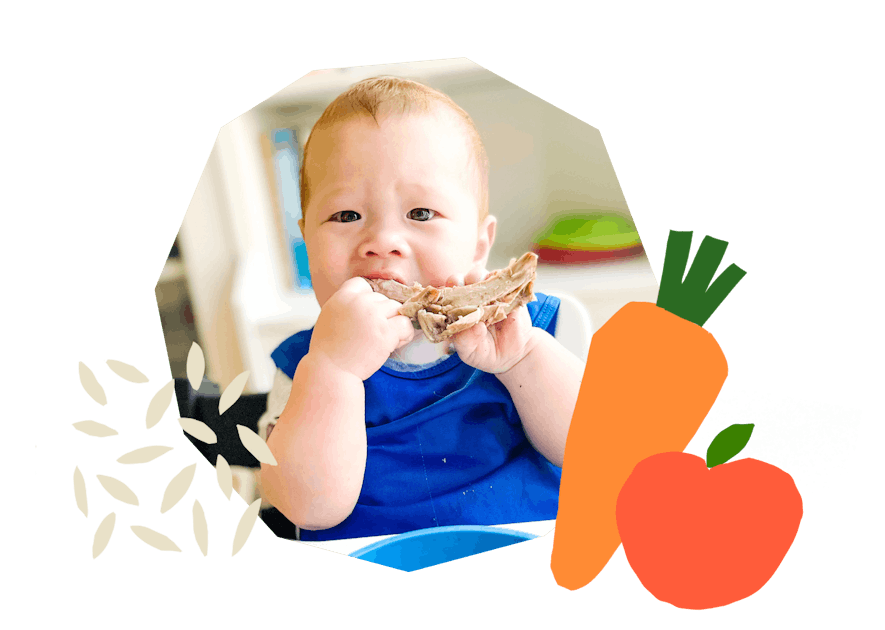
The Program Baby-Led Weaning with Katie Ferraro
A step-by-step digital program for starting solid foods safely and navigating the original 100 FIRST FOODS™ meal plan with baby-led weaning.
 EXPERT-LED, PROVEN APPROACH TO EATING REAL FOOD
EXPERT-LED, PROVEN APPROACH TO EATING REAL FOOD CONCISE VIDEO TRAININGS TO MASTER BABY-LED WEANING
CONCISE VIDEO TRAININGS TO MASTER BABY-LED WEANING 100 FIRST FOODS DAILY MEAL PLAN WITH FOOD PREP VIDEOS
100 FIRST FOODS DAILY MEAL PLAN WITH FOOD PREP VIDEOS
Baby-Led Weaning for Beginners Free Workshop
Is your baby ready to start solid foods, but you’re not sure where to start? Get ready to give your baby a solid foundation to a lifetime of loving real food…even if you’re feeling overwhelmed or confused about this next stage of infant feeding.
Get baby-led weaning recipes and tips delivered to your email inbox.

